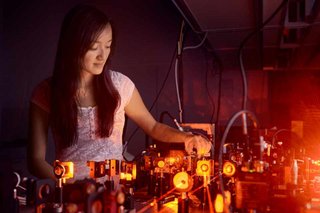A team of experimental physicists led by the University of Cologne have shown that it is possible to create superconducting effects in special materials known for their unique edge-only electrical properties. This discovery provides a new way to explore advanced quantum states that could be crucial for developing stable and efficient quantum computers. Their study, titled ‘Induced superconducting correlations in a quantum anomalous Hall insulator’, has been published in Nature Physics.
Superconductivity is a phenomenon where electricity flows without resistance in certain materials. The quantum anomalous Hall effect is another phenomenon that also causes zero resistance, but with a twist: it is confined to the edges rather than spreading throughout. Theory predicts that a combination of superconductivity and the quantum anomalous Hall effect will give rise to topologically-protected particles called Majorana fermions that will potentially revolutionize future technologies such as quantum computers. Such a combination can be achieved by inducing superconductivity in the edge of a quantum anomalous Hall insulator that is already resistance-free. The resultant chiral Majorana edge state, which is a special type of Majorana fermions, is a key to realizing ‘flying qubits’ (or quantum bits) that are topologically protected.
Anjana Uday, a final-year doctoral researcher in the group of Professor Dr Yoichi Ando and the first author of the paper, explained, “For this study we used thin films of the quantum anomalous Hall insulator contacted by a superconducting Niobium electrode and tried to induce chiral Majorana states at its edges. After five years of hard work we were finally able to achieve this goal: When we inject an electron into one terminal of the insulator material, it reflects at another terminal, not as an electron but as a hole, which is essentially a phantom of an electron with opposite charge. We call this phenomenon crossed Andreev reflection, and it enables us to detect the induced superconductivity in the topological edge state.”
Gertjan Lippertz, a postdoctoral fellow in the Ando group and co-first author of the paper, added, “This experiment has been tried by many groups in the past ten years since the discovery of the quantum anomalous Hall effect, but no one has succeeded in it before. The key to our success is that the film deposition of the quantum anomalous Hall insulator, every step of device fabrication, as well as ultra-low-temperature measurements are all done in the same lab. This is not possible elsewhere.”
To achieve these results, the Cologne group collaborated with colleagues at KU Leuven, the University of Basel as well as Forschungszentrum Jülich. The latter contributed theory support within the joint Cluster of Excellence Matter and Light for Quantum Computing (ML4Q). ”The Cluster has been instrumental in providing the collaborative framework and resources necessary for this breakthrough,” elaborated Yoichi Ando, Professor of Experimental Physics at the University of Cologne and spokesperson of ML4Q.
This discovery opens up numerous avenues for future research. Next steps include experiments to directly confirm the emergence of chiral Majorana fermions and to elucidate their exotic nature. Understanding and harnessing topological superconductivity and chiral Majorana edge states could revolutionize quantum computing by providing stable qubits that are less susceptible to decoherence and loss of information. The platform demonstrated in this study offers a promising path towards achieving these goals, potentially leading to more robust and scalable quantum computers.
Media Contact:
Professor Dr Yoichi Ando
Institute of Experimental Physics of the University of Cologne
+49 221 470 3570
andoph2.uni-koeln.de
Press and Communications Team:
Dr. Marian Barsoum
ML4Q Public Outreach Manager
+49 178 304 1884
marian.barsoumuni-koeln.de
Publication:
https://www.nature.com/articles/s41567-024-02574-1
Further informationen:
Cluster of Excellence ML4Q - Matter and Light for Quantum Computing
